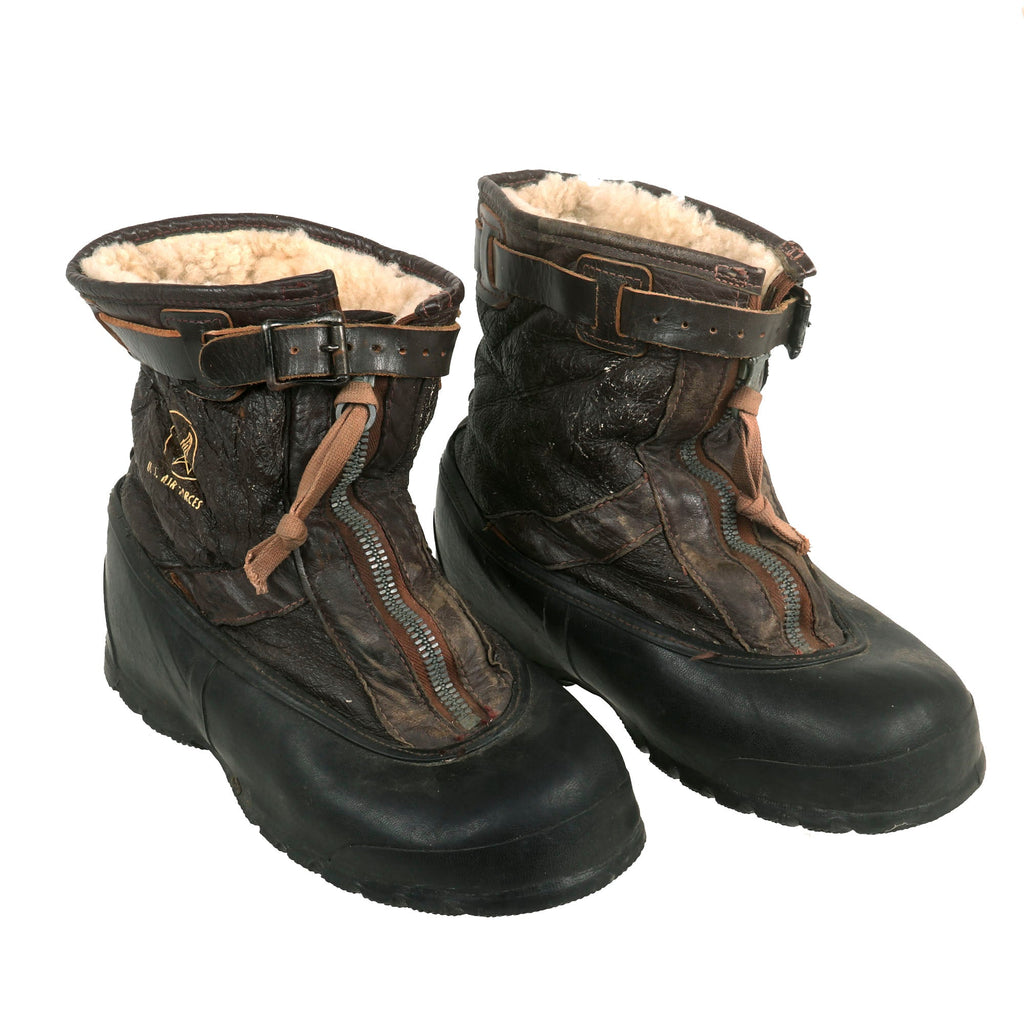Item Description
Original Items: Only One Pair Available. Excellent lightly used matched pair of Korean War Era US Air Forces flying boots made from shearling fleece with molded rubber soles. These were improved from the Type A-6 by adding leather straps over the ankle to help prevent the boots from falling off during a parachute descent. These new models were the A-1s, with the only difference being the leather strap. Fleece and leather is in very good condition with minimal damage and wear.
Rubber shoe sections are soft and pliable and show very little wear. Zippers retain original pullers and are intact and working. Leather straps and buckles are all present and in solid condition. Thick, fleece lining and clear labels with heavy CROWN zippers.
Both zippers are stiff and if properly worked through, will function again, if you wish. Overall very good condition.
Comes more than ready for further research and display.
The origins of many flying shoes and boots can be traced back to World War I. The Aviation Clothing Board, established in 1917, procured high-top leather boots and sheepskin lined “arctics” with clasps for winter wear by men in the Air Service during that war. High-top, brown leather, fleece- and fur-lined moccasin-type boots were also developed; they resembled the later Type A-6 boot but had a soft sole. A smooth-sole style of moccasin was often called the “barefoot” type since it had no separate sole and heel. Moccasin-type flying boots could be worn over standard Army service shoes or boots and proved to be both efficient and comfortable. They were further refined and developed at McCook Field during the 1920s, and a low, brown leather, sheep-skin-lined type of aviator’s moccasin, the Type A-1, Spec. 3000, was adopted as limited standard on February 19, 1924. The A-1 was not declared obsolete until March 13, 1944. It had a smooth sole and was secured by three straps with buckles. Originally called a moccasin, the A-1 was usually referred to in later years as a flying shoe.
Shoes were designated separate from moccasins. The A-1 designation for shoes was not used, perhaps to prevent confusion with the A-1 moccasin. The Type A-2 “Shoes, Aircraft, Pilot’s,” later called “Shoes, Flying, Winter,” were standardized on August 29, 1928. The leather A-2 shoes were also of moccasin style, were sheepskin lined, and had zipper instead of buckle closures. Their status changed to limited standard on March 27, 1937, and a few were worn during World War II until they were declared obsolete on March 27, 1944.
The Type A-3 was an experimental leather high-top shoe similar to the A-2. It had a lace front, a zipper rear closure, and no heel. The A-4 was constructed of a leather outer shell and was lined with three-ply quilted-wool blanket material. It was laced up the front and had a hard leather sole and heel. The A-4 was service tested in 1930-31 and was maintained in small supply as a nonstandard issue. The shoe was finally discontinued during World War II.
Most later types of shoes, beginning with the Type A-5, saw long service. The A-5 was a moccasin type with a horsehide outer shell and was lined with sheep shearling. It had a hard leather sole and low heel, a lace opening front, and a zipper in back. The Type A-5 flying shoe was service tested beginning in 1934 and adopted as a limited standard on May 22, 1935. It was declared obsolete on March 27, 1944, after almost ten years of limited use.
One of the best-known flying shoes ever used by the Army was the Type A-6. Its improved shearling design incorporated refinements learned during both extensive service testing of prototypes and service use of the A-5 shoe. The A-6 was a “heavy shoe” intended for use with shearling winter clothing, particularly the B-3 jacket, A-3 trousers combination. Service tests on the A-6 began on May 15, 1930, and the shoe was finally standardized on March 27, 1937. It was a shearling shoe made with three-fourths-inch fiber and had a zipper in front and a rubber sole. The outside of the ten-inch-high upper was waterproofed in later years with a brown polyacrylate dye and a lacquer finish. It provided suitable protection in the intermediate temperature range and was also satisfactory for wear over electric shoes and inserts. The A-6 proved, however, to be cumbersome and bulky for fighter pilots and ball turret gunners.
- This product is available for international shipping.
- Eligible for all payments - Visa, Mastercard, Discover, AMEX, Paypal & Sezzle











